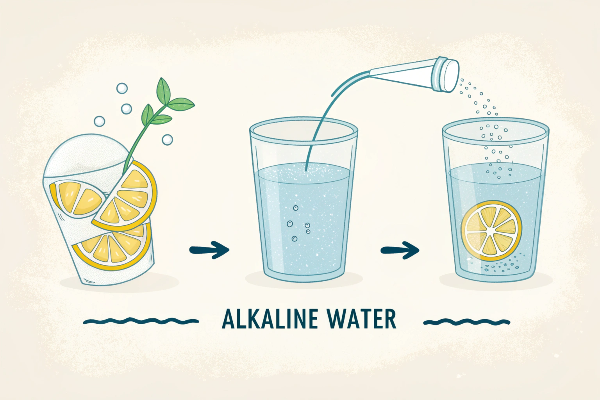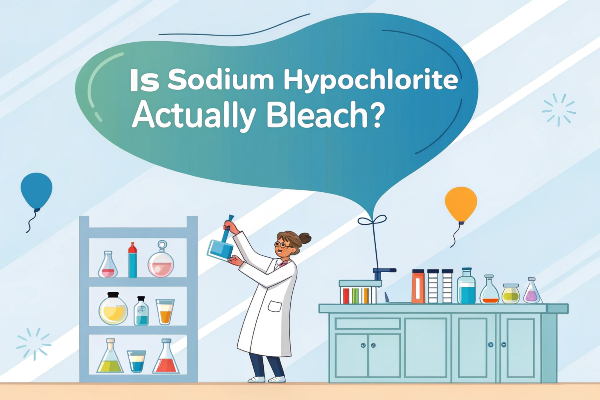Struggling with rising manufacturing costs? Searching for ways to save money without losing quality? Electroplating might be the cost-saving solution you’ve overlooked, and I’ve seen it work wonders.
Electroplating helps save money primarily by allowing the use of cheaper base materials coated for performance and appearance. It also extends product life, reducing warranty claims and replacement needs, directly impacting your bottom line.
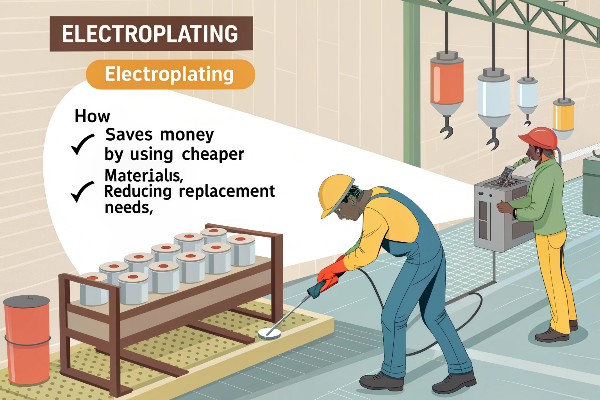
You see the potential, but how does this work in practice? It’s not just theory; these are strategies I’ve helped implement successfully. Let’s break down the specific ways electroplating can make a real difference to your manufacturing costs. We’ll explore material swaps, lifespan boosts, comparisons with other methods, process tweaks, and real examples.
Which specific material substitutions using electroplating offer the best cost savings?
Paying too much for solid stainless steel or gold parts? Finding functional, cheaper alternatives feels impossible sometimes, right? Electroplating creates cost-effective material substitutions that actually work in many situations.
The best savings often come from replacing expensive solid metals. Think nickel/chrome-plated carbon steel instead of stainless steel, or gold-plated brass/zinc instead of solid gold. These electroplating material substitution savings1 can significantly cut raw material expenses.
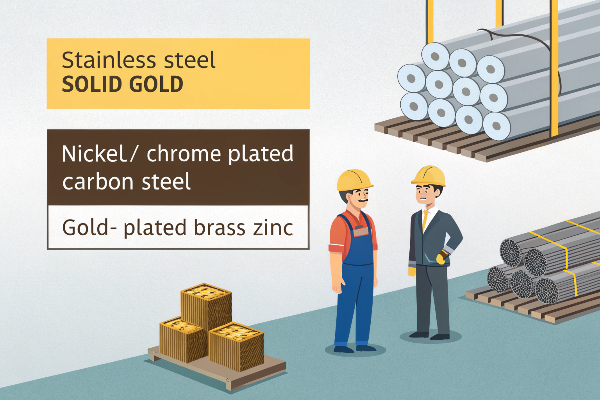
Let’s dive deeper into how this works. The core idea is simple: use a strong, inexpensive base material (the substrate) for the bulk of the part, and then apply a thin layer of a more expensive or functional metal only where it’s needed – on the surface. This gives you the desired properties (like corrosion resistance, conductivity, or appearance) without paying for a solid block of premium material. I remember a project where switching from solid brass connectors to gold-plated zinc alloy saved the client nearly 40% on material costs alone, a huge win for their manufacturing material cost reduction2 efforts.
Common Cost-Saving Combinations
Here are some typical examples I’ve seen yield great results:
| Original Material | Cheaper Substrate + Plating | Key Benefit | Estimated Savings* | Typical Applications |
|---|---|---|---|---|
| Stainless Steel (304) | Carbon Steel + Nickel/Chrome Plate | Corrosion, Looks | 30-50% | Handles, fixtures, decorative trim |
| Solid Brass | Zinc Alloy + Brass Plate | Appearance, Cost | 25-45% | Plumbing fixtures, decorative hardware |
| Solid Copper | Brass/Steel + Copper Plate | Conductivity, Cost | 20-40% | Electrical contacts (non-critical) |
| Solid Gold | Brass/Copper + Gold Plate | Conductivity, Looks | 70-95%+ | Electronic connectors, jewelry |
| Hot-Dip Galvanized Stl | Steel + Electro-Zinc Plate | Corrosion (mild) | 10-25% | Fasteners, brackets, enclosures |
(Savings are estimates and vary based on market prices, part geometry, and plating thickness)*
These cost-effective plating alternatives3 are incredibly useful. The steel plating vs stainless steel cost4 difference is often a major driver. Similarly, exploring gold plating substitute cost5 options like palladium-nickel or even silver plating (depending on the application) can yield massive savings when dealing with precious metals. Using cheap base metal plating techniques effectively is a key strategy.
Understanding the Trade-offs
Now, it’s important to be realistic. While these substitutions save money, they aren’t always a perfect 1-for-1 replacement. For instance, nickel/chrome-plated steel might not withstand extremely corrosive environments quite as well as high-grade stainless steel. A gold-plated connector might have slightly higher contact resistance than a solid gold one. You need to evaluate if the plated alternative meets the actual functional requirements of your specific application. Often, the performance is more than sufficient, making the cost savings a smart business decision. The trick is understanding the demands of the part and choosing the right plating combination.
How does extending product lifespan through electroplating translate into direct cost benefits for manufacturers?
Are warranty costs and product failures eating into your profits? These issues hurt your bottom line and your brand’s reputation, often more than we initially calculate. Electroplating extends product life, providing real financial relief.
Extending product lifespan via electroplating directly cuts costs by reducing warranty claims, returns, and repairs. This enhanced electroplating durability cost savings6 translates to tangible financial benefits and improved customer satisfaction, protecting your profit margins.
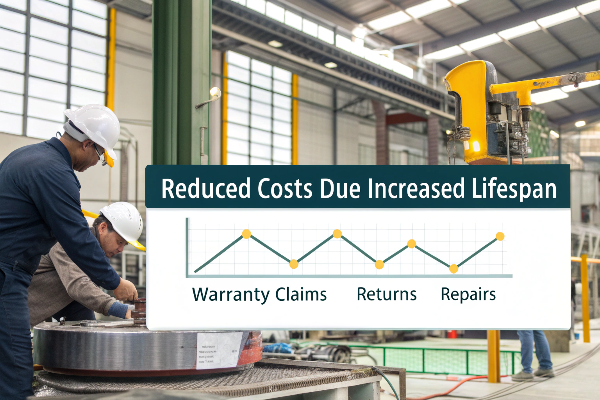
Let’s look closer at how durability turns into dollars saved. It’s not just about the part lasting longer; it’s about the consequences of it not lasting. Every time a product fails prematurely under warranty, you incur costs – replacement parts, shipping, labor for repair or replacement, and administrative overhead. These add up fast. In my experience, clients often underestimate these "hidden" costs until we actually track them.
Reducing Tangible Costs (Warranty & Replacement)
This is the most direct benefit.
- Wear Resistance: Think about moving parts – gears, pistons, shafts. Applying a hard coating like hard chromium or electroless nickel with phosphorus significantly reduces friction and wear. This means fewer breakdowns during the expected service life (and crucially, during the warranty period). Lower replacement frequency saves material costs, labor, and reduces operational downtime for your customers (which also reflects well on you). This wear resistance coating ROI7 can be surprisingly high. I saw one company reduce field failures on a hydraulic component by over 20% just by switching to a more robust plating specification.
- Corrosion Resistance: For products used outdoors, in humid environments, or exposed to chemicals, corrosion is a major enemy. Coatings like zinc, zinc-nickel, tin, or multi-layer nickel-chrome act as a barrier. This corrosion protection economic benefits8 directly by preventing rust or other corrosion that leads to failure. This directly helps reduce warranty costs manufacturing because the product simply performs as expected for longer under challenging conditions. Fewer rust-related returns mean direct savings. Some industry data suggests companies can cut warranty claims by 10-15% or more by implementing appropriate corrosion-resistant plating.
Boosting Intangible Value (Reputation & Loyalty)
Beyond the direct warranty savings, think about the long-term picture. Products that last build customer trust and loyalty. Fewer failures mean fewer customer complaints, better online reviews, and a stronger brand reputation. This leads to repeat business and positive word-of-mouth referrals – valuable marketing you don’t have to pay for directly. While harder to quantify precisely, this enhanced reputation driven by product lifespan extension plating9 certainly contributes to electroplating long-term savings10 by fostering a loyal customer base less likely to switch to competitors.
What is the cost comparison of electroplating versus other finishing processes like powder coating or PVD for cost-sensitive applications?
Confused about choosing between electroplating, powder coating, or PVD? It’s a common headache, and making the wrong choice can be surprisingly costly in the long run. Let’s directly compare these finishing processes for cost-effectiveness.
Electroplating often provides a lower unit cost compared to PVD, especially for thin, precise, or conductive layers. It’s generally more cost-effective than powder coating for achieving specific metallic looks or functional properties like solderability.
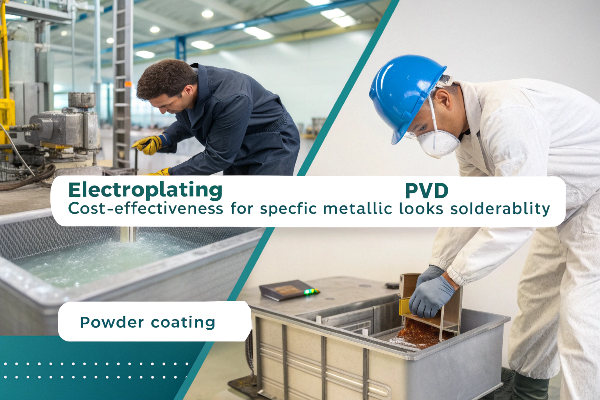
Choosing the right surface finish involves balancing cost, performance, appearance, and production volume. There’s no single "best" process; the ideal choice depends heavily on your specific needs. Let’s break down the electroplating vs PVD cost comparison11 and electroplating vs powder coating cost12 factors. I always advise clients to think about the total cost, including setup, per-part cost, and how well the finish meets the actual requirements.
Head-to-Head: Electroplating vs. Alternatives
Here’s a simplified comparison for common cost-effective surface treatment manufacturing options:
| Feature | Electroplating | Powder Coating | PVD (Physical Vapor Deposition) |
|---|---|---|---|
| Typical Unit Cost | Low to Medium | Low to Medium | Medium to High |
| Initial Setup Cost | Medium to High (line setup) | Medium | High (vacuum equipment) |
| Typical Materials13 | Metals (Fe, Cu, Zn, Ni, Cr, Sn, Ag, Au) | Polymers (Epoxy, Polyester) | Metals, Ceramics (TiN, CrN) |
| Substrates | Conductive (Metals, some plastics) | Metals, some MDF | Metals, Ceramics, some plastics |
| Key Benefit14 | Conductivity, Solderability, Thin layers, Specific metal look, Corrosion/Wear (specific types) | Thick layers, Good edge coverage, Durable color, Good general corrosion | Very hard, Wear resistant, Thin, Biocompatible, Wide color range |
| Thickness | Very Thin to Medium (µm range) | Medium to Thick (mils range) | Very Thin (µm range) |
| Environment | Chemical baths, Wastewater Tx needed | Overspray recovery possible, VOCs | Vacuum, Clean process |
| Best For15 | Electronics, Connectors, Precision parts, Specific metallic looks, High volume small parts | Outdoor furniture, Appliances, Automotive chassis, General industrial | Cutting tools, Medical implants, High-wear decorative, Watches |
This metal coating cost analysis16 shows electroplating shines when you need thin, precise metallic coatings, especially if electrical conductivity or solderability is required. While powder coating might be the cheapest metal finishing process17 for applying a thick, durable, colored layer on less complex shapes, it can’t replicate the properties of a metal layer. PVD offers excellent hardness and thin films but comes with significantly higher equipment costs and often higher per-part costs, making it less suitable for many purely cost-sensitive applications unless its specific high-wear properties are essential. Finding good powder coating alternatives cost18-effectively often leads back to specific electroplating solutions.
Making the Right Choice for Your Application
So, how do you choose?
- Define Your Needs: What is the primary function? Corrosion resistance? Wear? Conductivity? Appearance?
- Consider the Substrate: What material is your part made from?
- Volume Matters: Are you making thousands of small parts or a few large ones? High volumes often favor electroplating or powder coating lines due to efficiency.
- Budget Constraints: What is your target cost per part? What is your capital budget for equipment?
For many general manufacturing applications needing basic corrosion protection or a specific metallic look on metal parts, electroplating offers a very competitive balance of performance and cost.
Are there specific electroplating process optimizations that directly reduce operational costs (energy, chemicals, waste)?
Worried about the running costs of electroplating itself, even after choosing cost-effective materials? I get it. Energy bills, chemical usage, and waste disposal can really add up. Smart process optimization offers direct savings here.
Yes, optimizing the electroplating process directly cuts operational costs. Using high-efficiency rectifiers saves energy, advanced filtration reduces chemical use and waste, and better racking minimizes drag-out. These efficient plating techniques19 significantly boost your bottom line.
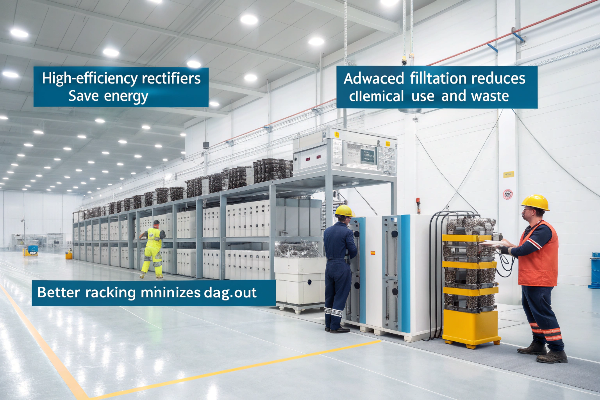
Focusing on how the plating line runs is crucial to reduce electroplating operational expenses20. It’s not just about the materials you plate onto, but the resources you consume during plating. Let’s look at where the biggest savings opportunities usually lie. One simple change I saw make a big difference was just optimizing the rack design – it sounds basic, but it cut drag-out losses by nearly 15%, saving valuable chemistry.
Targeting Energy Consumption
Energy is often one of the largest operational costs in a plating shop.
- High-Efficiency Rectifiers: Older rectifier technology can be incredibly inefficient (sometimes only 60-70%). Modern switch-mode power supplies (SMPS) can operate at 90% efficiency or higher. This means significantly less electricity is wasted as heat for the same amount of plating current delivered. The electroplating energy saving21 potential here is substantial.
- Optimized Current Density: Running baths at the lowest effective current density that still produces quality results saves energy. This often requires careful process control and understanding the bath chemistry.
- Tank Insulation & Covers: Simple measures like insulating heated tanks and using covers when not in use reduce heat loss, saving energy required for heating.
Minimizing Chemical and Waste Costs
Chemicals and waste treatment are the other major operational expenses.
- Reduce Drag-out: This is plating solution physically carried out of the tank on parts and racks. Optimizing rack design for better drainage, slowing withdrawal speeds, using drip shields, and installing "drag-out recovery" rinse tanks (where the first rinse water is returned to the plating bath to compensate for evaporation) can drastically cut electroplating chemical cost reduction22.
- Advanced Filtration & Purification: Using techniques like continuous filtration, carbon treatment (to remove organic contaminants), ion exchange, or even reverse osmosis can extend bath life significantly. This reduces the frequency of expensive bath dumps and remakes, and lowers electroplating waste treatment cost23. Some systems allow for selective recovery of valuable metals from rinse waters.
- Bath Maintenance & Analysis: Regular analysis and maintenance keep baths operating optimally, preventing costly rejects or the need for premature bath replacement due to imbalance or contamination.
- Greener Chemistries: Moving towards chemistries that operate at lower temperatures, have wider operating windows, or are less hazardous (like replacing cyanide baths) can reduce energy, chemical consumption, and waste treatment complexity.
Leveraging Automation and Better Design
- Automation: Automated hoist lines ensure consistent transfer times, immersion times, and drainage times, leading to more stable processes, less human error, fewer rejects, and optimized chemical usage compared to manual lines.
- Efficient Plant Layout: Designing the line layout to minimize transfer distances and allow for efficient workflow also contributes to overall operational efficiency.
Implementing these strategies requires investment, but the long-term savings achieved when you optimize electroplating process cost24 almost always provide a strong return.
Can you provide real-world examples or case studies where manufacturers significantly cut costs using electroplating?
Hearing about potential savings is one thing, but seeing proof is definitely more convincing, isn’t it? You need real examples before investing time and resources. Let’s look at actual, anonymized cases where electroplating cost saving case study25 examples show tangible results.
Absolutely. Many manufacturers, especially in automotive, electronics, and hardware, have achieved significant manufacturing cost reduction examples electroplating26. Real-world case studies demonstrate savings in materials, warranty costs, and operational efficiency, proving the economic benefits.
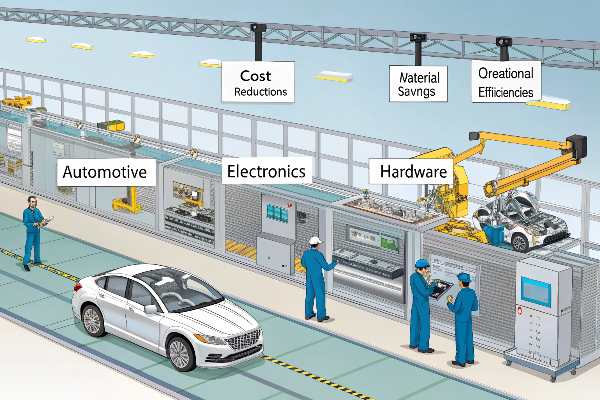
While specific company names and precise figures are often confidential, the patterns I’ve observed over the years are clear and consistent. Electroplating, when applied strategically, delivers measurable cost reductions. Here are a few typical scenarios illustrating the real-world electroplating cost analysis27.
Case Study 1: Automotive Supplier Saves on Fasteners
- Industry Background: A Tier 2 automotive supplier manufacturing various steel brackets and fasteners.
- Cost Challenge: Facing pressure from automakers to reduce costs, while needing reliable corrosion protection (e.g., 240-480 hours salt spray resistance). Their previous process involved a costly organic coating.
- Plating Solution: They transitioned to an alkaline Zinc-Nickel electroplating process. Zinc-Nickel offers excellent corrosion resistance, often exceeding requirements, at a competitive price point compared to thick organic coatings or potentially using stainless steel.
- Specific Cost Savings: By switching, they achieved roughly a 15% reduction in finishing cost per part. The process was also faster, improving throughput. This automotive plating cost savings proof helped them maintain their margins while meeting stringent performance specs.
Case Study 2: Electronics Manufacturer Cuts Connector Costs
- Industry Background: A company producing mid-range consumer electronics with numerous internal connectors.
- Cost Challenge: The rising price of gold was making their traditional gold-plated brass connectors increasingly expensive. Reliability was key, but the full performance of thick gold wasn’t strictly necessary for this application.
- Plating Solution: After careful testing, they transitioned to a selective plating process using a thinner layer of gold only on the critical contact points, over a nickel underlayer on a less expensive copper alloy base material. They explored gold plating substitute cost28 options too.
- Specific Cost Savings: This strategic move reduced the gold usage per connector significantly, leading to overall component cost savings estimated at over 25%. This highlights the electronics plating economic benefits29 achievable through careful material selection and process optimization.
Case Study 3: Hardware Producer Improves Durability & Reduces Returns
- Industry Background: A manufacturer of decorative cabinet hardware (handles, knobs).
- Cost Challenge: High return rates due to finish tarnishing and wearing off too quickly, leading to significant warranty replacement costs and damage to brand reputation. Their existing finish was a simple lacquer over brass plating.
- Plating Solution: They upgraded their finishing line to include a multi-layer plating system: a copper strike, followed by semi-bright nickel, bright nickel, a decorative chrome layer, and finally a clear electrophoretic coat (e-coat).
- Specific Cost Savings: While the initial finishing cost per piece increased slightly, the product lifespan and durability improved dramatically. Warranty claims related to finish failure dropped by over 60% within the first year. The reduction in return/replacement costs far outweighed the slightly higher finishing cost, leading to net savings and improved customer satisfaction. This is one of the many success stories electroplating manufacturing30 where looking beyond just the initial cost pays off.
These examples show that whether it’s through material substitution, process efficiency, or enhancing product durability to cut downstream costs, electroplating offers diverse pathways to significant financial savings in manufacturing.
Conclusion
So, as you can see, electroplating offers real, practical cost savings through smart material choices, extending product life, and optimizing the plating process itself. It’s a valuable tool for efficient, cost-effective manufacturing.
-
Explore this link to understand how electroplating can significantly reduce material costs while maintaining quality and functionality. ↩
-
Discover effective strategies for reducing manufacturing costs through innovative electroplating techniques. ↩
-
Explore this resource to discover various plating alternatives that can significantly reduce costs while maintaining quality. ↩
-
This link will provide insights into the cost differences between steel plating and stainless steel, helping you make informed decisions. ↩
-
Learn about the costs and benefits of gold plating substitutes to maximize savings in your projects. ↩
-
Explore this link to understand how electroplating can significantly reduce costs and enhance product longevity, benefiting your bottom line. ↩
-
Discover the financial advantages of wear resistance coatings and how they can lead to substantial savings and efficiency improvements. ↩
-
Learn about the economic impact of corrosion protection and how it can save manufacturers money by reducing warranty claims and failures. ↩
-
Explore this link to understand how product lifespan extension plating can enhance durability and customer loyalty, ultimately benefiting your business. ↩
-
Discover insights on how electroplating can lead to significant long-term savings, improving your business’s financial health. ↩
-
Understanding the cost differences can help you make an informed decision for your project, ensuring you choose the most cost-effective option. ↩
-
This comparison will provide insights into which finishing process offers better value for your specific application needs. ↩
-
Understanding the materials used in these processes can help you choose the right coating for your project. ↩
-
Exploring the benefits of each coating method can guide you in selecting the best option for your needs. ↩
-
Knowing the best applications for each method can help you make informed decisions for your projects. ↩
-
Understanding metal coating cost analysis can help you make informed decisions about the best coating methods for your needs. ↩
-
Exploring the cheapest metal finishing processes can save you money while ensuring quality in your projects. ↩
-
Discovering cost-effective alternatives to powder coating can enhance your project’s efficiency and budget management. ↩
-
Explore this link to discover innovative plating techniques that can significantly lower your operational costs and improve efficiency. ↩
-
This resource will provide insights into practical strategies for minimizing expenses in electroplating operations, ensuring better profitability. ↩
-
Learn about energy-saving practices in electroplating that can lead to substantial cost reductions and enhance sustainability in your operations. ↩
-
Explore this resource to discover innovative strategies that can significantly lower your electroplating chemical expenses. ↩
-
This link will guide you through advanced techniques to minimize waste treatment costs in electroplating, enhancing your operational efficiency. ↩
-
Learn about proven practices that can help you streamline your electroplating process and achieve substantial cost savings. ↩
-
Explore this link to discover detailed case studies showcasing how electroplating has led to significant cost savings for manufacturers across various industries. ↩
-
This resource will provide insights into specific examples of manufacturers who have successfully reduced costs using electroplating techniques. ↩
-
Delve into this link for an in-depth analysis of how electroplating can lead to substantial cost reductions in manufacturing processes. ↩
-
Exploring alternatives to gold plating can reveal cost-effective solutions that maintain quality without compromising performance. ↩
-
Understanding the economic benefits of electronics plating can help manufacturers optimize costs and improve product quality. ↩
-
Learning from success stories in electroplating can inspire innovative approaches to cost reduction and efficiency in manufacturing processes. ↩



